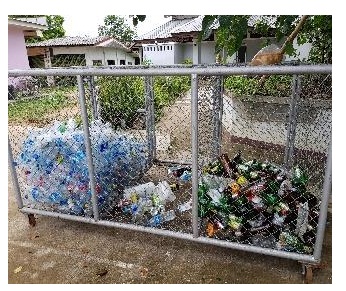Participatory solid waste management in the San Khong Noi community, Chiang Rai Municipality
Main Article Content
Abstract
The purposes of this research were to study the conditions, factors, and participatory solid waste management in the San Khong Noi community, Chiang Rai Municipality, and distill the lessons of participatory waste management in the community. We conducted the research using a qualitative method, gathering data from household representatives among 50 and 15 community committees. The research tools used were SWOT and TOWS analyses, the CIPP model, guide interview structure, and focus group discussion. We gathered the data using content analysis and synthesis, then composed it into a descriptive research report. The study revealed that San Khong Noi is an urban community with a garbage problem. Garbage from various activities has increased in both households and communities, contributing to the problem. Factors that support success in community solid waste management include community leaders, community committees, village health volunteers, and villagers working together to manage solid waste using the 3R principles: reduce, reuse, recycle, and 5Kor. The 5Kor components, which include a group, fund, rules, activities, and committee, work together to create an efficient community solid waste management model, such as a “Recyclable Waste Bank, etc. The Chiang Rai Municipality and the Chiang Rai Provincial Office have come together to support the budget and implement a concrete waste management plan. We recommend applying the concept of community solid waste management to enhance each urban community's solid waste management outcomes and contribute to the reduction of waste in the province and country.
Article Details
References
กรมควบคุมมลพิษ. (2559). คู่มือสำหรับองค์กรปกครองส่วนท้องถิ่นเรื่องแนวทางการบริหารจัดการและพิจารณาคัดเลือกรูปแบบเทคโนโลยีการจัดการขยะที่เหมาะสมเบื้องต้น. กระทรวงทรัพยากรธรรมชาติและสิ่งแวดล้อม. กรุงเทพฯ: บริษัท ธนสิริ ปริ้นติ้ง จำกัด.
กรมควบคุมมลพิษ. (2559). แผนแม่บทการบริหารจัดการขยะมูลฝอยของประเทศ (พ.ศ.2559–2564).
กระทรวงทรัพยากรธรรมชาติและสิ่งแวดล้อม. กรุงเทพฯ: บริษัท แอคทีฟพริ้นท์ จำกัด.
กรมควบคุมมลพิษ. (2560). รายงานสถานการณสถานที่กําจัดขยะมูลฝอยชุมชนของประเทศไทย ป พ.ศ.2560. กระทรวงทรัพยากรธรรมชาติและสิ่งแวดล้อม.
กรมควบคุมมลพิษ. (2561). รายงานสถานการณสถานที่กําจัดขยะมูลฝอยชุมชนของประเทศไทย ป พ.ศ.2561. กระทรวงทรัพยากรธรรมชาติและสิ่งแวดล้อม.
กรมควบคุมมลพิษ. (2562). รายงานสถานการณ์มลพิษของประเทศไทย ปี 2562. กรมควบคุมมลพิษ
กระทรวงทรัพยากรธรรมชาติและสิ่งแวดล้อม. กรุงเทพฯ: บริษัท สไตล์ครีเอทีฟเฮ้าส์ จำกัด
เทศบาลนครเชียงราย. (2563).สรุปค่าดำเนินงานระบบการจัดการขยะมูลฝอย งบประมาณ ปี พ.ศ.2563. (เอกสารอัดสำเนา).
เทศบาลนครเชียงราย. (2564). รายงานผลการดำเนินงานระบบกำจัดขยะมูลฝอยและสิ่งปฏิกูลเทศบาล
นครเชียงราย งบประมาณประจำปี พ.ศ.2564. (เอกสารอัดสำเนา).
ปราการ เกิดมีสุข. (2560). การมีส่วนร่วมในการจัดการธนาคารขยะของชุมชนวัดปุรณาวาส เขตทวีวัฒนา กรุงเทพมหานคร (ระยะที่ 1). วารสารวิชาการ มหาวิทยาลัยกรุงเทพธนบุรี, ปีที่ 6 ฉบับที่ 2 กรกฎาคม-ธันวาคม 2560.
ศรัณรัตน์ ศิลปักษา และผ่องพรรณ มุริกานนท์. (2562). การมีส่วนร่วมของชุมชนและภาคีเครือข่ายในการพัฒนาระบบการจัดการขยะมูลฝอยเทศบาลตำบลอาจาสามารถ อำเภออาจสามารถ จังหวัดร้อยเอ็ด. วารสารวิชาการสาธารณสุข, ปีที่ 28 ฉบับที่ 3 พฤษภาคม-มิถุนายน 2562.
ศาลิมาร์ เกิดกลิ่นหอม และณพงศ์ นพเกตุ.(2563). แนวทางการมีส่วนร่วมของประชาชนในการจัดการขยะมูลฝอยในเขตเทศบาลนครศรีธรรมราช. วารสารการจัดการสิ่งแวดล้อม. ปีที่ 16 ฉบับที่ 2/2563, 61-73.
สำนักงานส่งเสริมการปกครองส่วนท้องถิ่นจังหวัดเชียงราย. (2566). แผนปฏิบัติการจัดการขยะมูลฝอยชุมชน “จังหวัดสะอาด” ประจำปีงบประมาณ พ.ศ.2566 จังหวัดเชียงราย. http://www.chiangrailocal.go.th/system_files/308/dc7fe3afbd2a997182ee1bd32a5ac74d.pdf
สุเมธี จิตต์ประภัสสร. (2562). บทบาทของผู้นำชุมชนในการสร้างการมีส่วนร่วมในโครงการขยะเหลือศูนย์ กรณีศึกษาเทศบาลตาบลโนนดินแดง จังหวัดบุรีรัมย์. การศึกษาตามหลักสูตรรัฐศาสตรมหาบัณฑิต (บริหารรัฐกิจและกิจการสาธารณะ) สาขาวิชาบริหารรัฐกิจและกิจการสาธารณะ สำหรับนักบริหาร คณะรัฐศาสตร์ มหาวิทยาลัยธรรมศาสตร์
อเนก ฝ้ายจำปา. (2563).การพัฒนารูปแบบการจัดการขยะแบบมีส่วนร่วมขององค์การบริหารส่วนตำบลจอมศรี อำเภอเชียงคาน จังหวัดเลย.วารสารสภาการสาธารณสุขชุมชน,ปีที่ 2 ฉบับที่ 1 (มกราคม-เมษายน)2563.
Gufur, A., Selintung, A., Rahim, M. R., & Patanduk, J. (2017). Community-Based Solid Waste Management Models in the Heterogeneus Region of Palu. International Journal of Civil Engineering and Technology (IJCIET) Volume 8, Issue 10, October 2017, pp. 1181–1190.
Singhirunnusorn, W., Donlakorn, K., & Kaewhanim, W. (2012). Contextual Factors Influencing Household Recycling Behaviours: A Case of Waste Bank Project in Mahasarakham Municipality. Social and Behavioral Sciences, 36(2012) 688-697.


